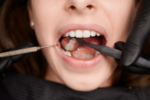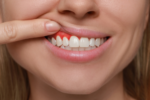Tooth pain and sinus infection can have very similar symptoms. Whether you’re struggling with fever, headache, lower jaw pain, or a cough, telling these two conditions apart is easier said than done. It’s not uncommon for patients to consult their dentist for tooth pain when a sinus infection is a hidden cause.
Quick Facts
Tooth Pain
Tooth pain is typically localized to the affected tooth. It can be sharp, throbbing, or constant and might worsen when you bite down or apply pressure. Tooth pain can also be caused by other dental problems such as cavities, gum disease, or a cracked tooth.Sinus Infections
Sinus infections typically cause pain in the cheeks, forehead, or bridge of the nose, and the pain is usually more generalized rather than localized to a specific tooth. Sinus pain might be accompanied by other symptoms like a stuffy or runny nose, headache, fever, and fatigue. Despite mimicking each other, these conditions are quite dissimilar – needing very different treatments. Still, it’s hard to tell a toothache and a sinus infection apart. Use our helpful tips below to determine the difference between a local tooth issue and symptoms associated with a broader sinus infection. If you have any confusion or concerns, we’re here for you at our dental clinic in Red Deer.What is a sinus infection?
A sinus infection, or sinusitis, is a condition where your nasal cavities become infected and inflamed. Because your sinus is a closed space, fluid builds up, leading to swelling and bacterial or viral growth. The result is a sinus infection. Most sinus infections are caused by a virus and can be tricky to treat. Lower jaw pain can occur with the pressure from the fluid on the surrounding structure. Most commonly, you’ll experience symptoms of:- Facial pain, tenderness, or sinus pressure: in the forehead, nasal area, between your eyes, cheekbones, or in the upper jaw and teeth. (Lower jaw pain sinus infections can also occur.)
- Runny nose: cloudy, green, or yellow discharge as infected fluids drain from your nasal cavity.
- Nasal congestion: a feeling of a blocked nose restricting your nasal breathing.
- Cough or throat irritation: sinuses drain into your throat – especially when lying down – leading to a persistent cough.
- Fever: Sinusitis is an infection; as such, a low-grade fever (38 to 39.4 degrees C) is not uncommon. Sore throat or hoarse voice
- Bad breath: caused by the sinus drip into your mouth and throat.
What is a toothache?
Toothache, or tooth pain, is not a diagnosis but a symptom. It can be caused by tooth decay leading to a dental abscess, an impacted tooth, and, more rarely, due to nerve conditions. The most common symptoms of toothache are:- Tenderness or ache around a specific tooth
- Throbbing or swelling around your tooth or gum
- Sharp pain when touching or biting down on a tooth
- Painful sensitivity to hot or cold foods or drinks
- Discoloured teeth
- Foul taste in the mouth or bad breath
- Discharge from tooth or gums
- Fever
Tooth pain or sinus infection: How to tell the difference
It’s hard to tell the difference between sinusitis and toothache because the roots of your upper teeth are close to your sinuses. So, when the infected sinuses press down, your upper teeth hurt as a result. Very confusing!Review Your Symptoms
When we glance over the symptom lists, we see a significant overlap. Both conditions are located within centimetres of each other; and involve some form of pressure or pain in the tooth region. Use the criteria below to help narrow down the reason you’re experiencing pain in your tooth or jaw:- Understand the cause. Your sinuses, as we’ve mentioned, are located very close to your tooth nerves and the roots of your upper molars and some premolars. When irritated, swollen, or infected, your sinuses exert pressure on these roots and nerves, leading to pain. You’ll typically find sinus pain is more diffuse, where the toothache is localised to a single tooth area.
- Pain type. Sinusitis is less intense and less localised than a toothache. Because it’s merely applying pressure to the tooth and jaw area, it’s most often described as an “ache”. In contrast, tooth pain is often felt sharply, being centralised to a specific tooth. Toothache is also constant and progressive, while sinus infections tend to be more intermittent.
- Pain triggers. Pay attention to the timing and triggers of your pain. Tooth pain is often triggered by hot or cold foods, sugary foods, or pressure on the affected tooth. Sinus pain, on the other hand, may be worsened by changes in barometric pressure or weather, and may be more severe in the morning or at night.
- Lower jaw. Because sinusitis pressures only the upper jaw, you may imagine lower jaw pain is specific to tooth pain. Yes, this is generally true. However, it doesn’t rule out the possibility of a lower jaw pain sinus infection. Known as “referred pain”, the pressure on the upper jaw and adjacent areas may be felt as discomfort in the bottom teeth. Moreover, a “misaligned bite” due to the swelling around the upper teeth can mean sinusitis causes soreness in both rows of teeth.
- One-sided. Toothache generally affects only one side of your jaw, being confined to a single tooth. Sinus infections, in contrast, affect both sides of the sinus cavity; pain will be felt on the left and the right.
- Other symptoms. Perhaps the best way to tell the conditions apart is with other symptoms. Sinusitis involves recurring allergies, runny nose, fever, headache, cough, phlegm, and fatigue – as your body tries to fight off the infection. Tooth pain is limited to in and around a tooth or a certain portion of the jaw: more severe infections will involve a bigger area. It can also cause fever and fatigue.










